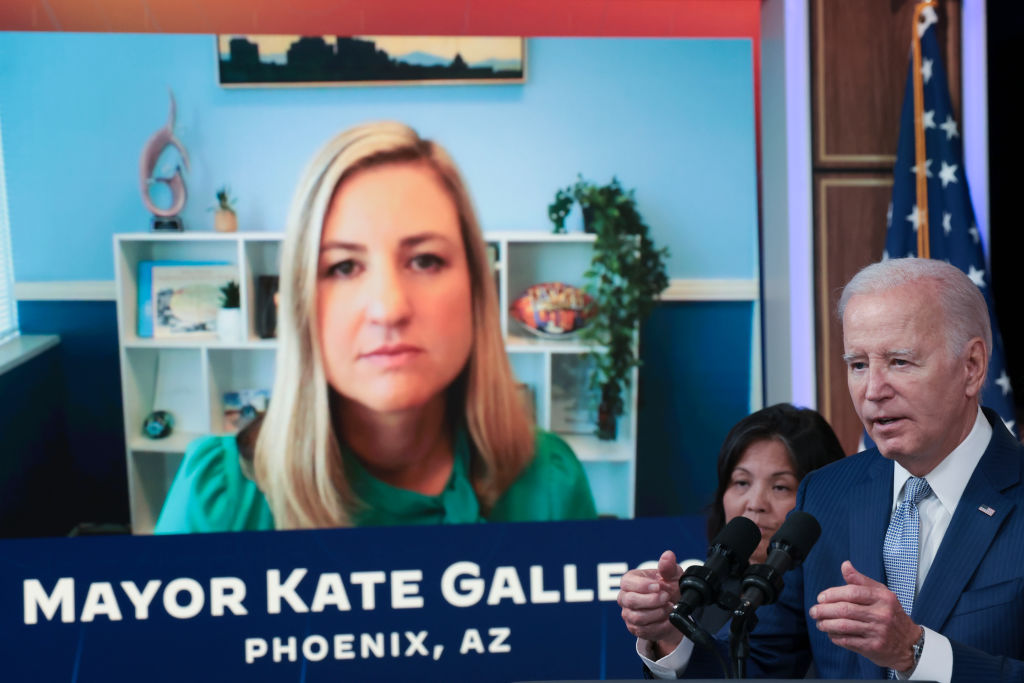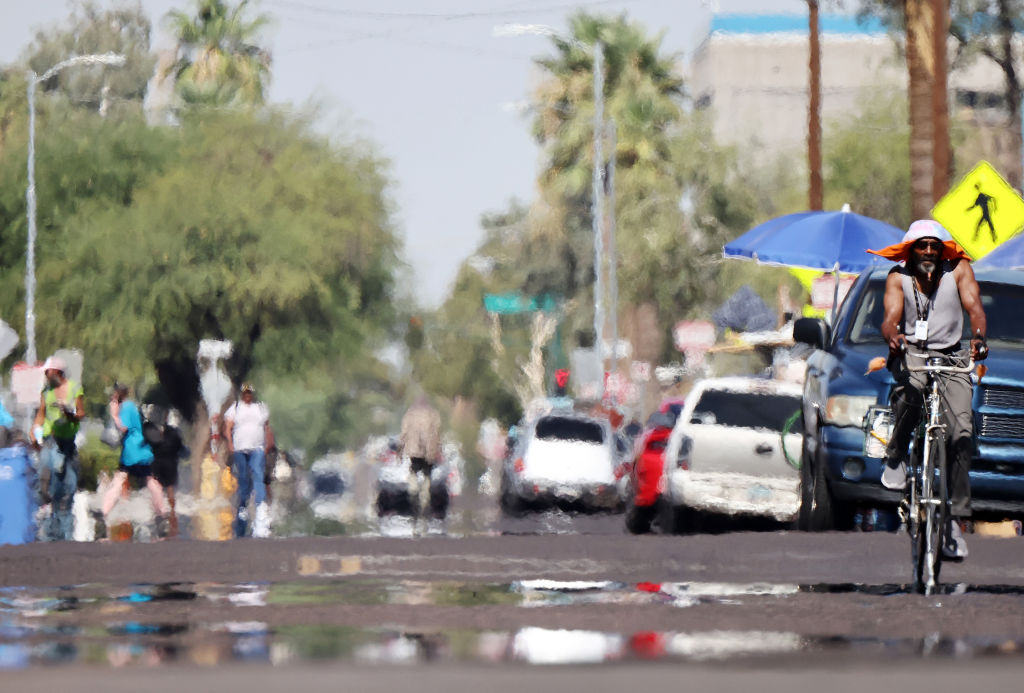Temperatures in Phoenix, Ariz. rose above 110°F for 31 straight days last month, a record-breaking spell of extreme heat that raised sidewalks to scalding temperatures, keeled over mighty saguaro cacti, and inundated hospitals with patients suffering from heat-related ailments. All told, Phoenix’s Maricopa County reported 39 heat-related deaths in July, with more than 300 others being investigated.
Such conditions are likely to come again soon. The first two weeks of August saw slightly cooler temperatures in the city, but they are projected to rise again in the coming days. And even after Phoenix residents make it through this summer and into the balmy winter months, global climate change likely means that yet more super-heat waves will be back in the years ahead.
The city has made efforts to adapt. Phoenix created the first publicly funded heat response office in the U.S. in 2021, and appointed a former environmental sciences professor as its leader. It’s painting roads with a reflective coating designed to absorb less heat, and it has launched an initiative to improve tree cover in poorer parts of the city. It’s also building new air-conditioned homeless shelters out of shipping containers.
Still, it remains to be seen if one of the country’s fastest-growing cities can adapt faster than temperatures rise. In the aftermath of the unprecedented stretch of extreme heat, TIME spoke with Phoenix Mayor Kate Gallego about the response to the brutal heat wave, and what the city has learned going forward.
The following interview has been edited and condensed for length and clarity.
Time: Phoenix just got out of an unprecedented heat wave. Can you tell us a bit about where things stand now?
Mayor Kate Gallego: Phoenix is the valley of the sun—we are used to hot summers. We have wonderful weather most of the year, but we know that every summer is going to be hot. This summer was record-breaking, particularly for days above 110 degrees. We got some rain last night so we're doing a little bit better today. But it was a very tough summer for our community, particularly for those who are most vulnerable.
There’s been a lot written about the desperate plight of poor and unhoused people in Phoenix dealing with these temperatures. What level of resources has that required from the city?
We have a network of more than 60 cooling centers where individuals can go. We have a program called Cold Callers where we can check on people who are likely to be most vulnerable to heat, including people with health challenges and older adults. We have a network of volunteers that can hand out cooling kits throughout our community as well as maps or resources related to heat. We are working as hard as we can to develop new shelter options—that's everything from hotels to creating housing out of shipping containers. As we speak, people are moving into a shipping container project that the city of Phoenix purchased with American Rescue Plan dollars. It's powered by solar energy with onsite batteries, and it's just one example of how we're trying to get shelter built quickly. Another advantage of the shipping container housing is that it can be manufactured indoors so that the construction workers who are building it have a little bit more protection from the summer heat.
Has this extreme heat meant that the city had to spend more on programs like those to keep people safe?
We have a lot of long term investments to try to increase the amount of affordable housing and shelter, and then we continue to invest in new programs every year. Every summer we learn more. We've learned a lot about mobile cooling units being very positive. We've learned new techniques that our firefighters use to cool people down, including getting ice baths out in the field. So yes, we are spending more than we have before, but we're also getting smarter and tracking which solutions really deliver.

What else have you learned about what solutions really work, and which aren’t as useful in dealing with extreme heat?
We have found that really looking at the built environment, including the materials you choose, can be very important. Green buildings have performed [much better]. We have a cool pavement program where we do a lighter colored sealant on city streets, and Arizona State University has found about a 10-12 degree cooling impact [from that]. We're looking at a variety of different programs in the water area, which range from protecting our water supply to just getting out water to our community. We have a variety of programs on reducing greenhouse gas emissions. One that has been very popular is in our key transit corridors, such as our downtown, [where] we are pushing towards 75% shade cover—that will be a mix of planting trees and using things like canopies in the built environment. And that makes a really significant impact and allows people to move about more successfully. Having a heat office that is focused completely on this challenge has been a great success for us. Having a one stop shop where people can go with ideas and challenges around heat really gives us more momentum to get things done.
Do you think there's any misconceptions among people from other parts of the U.S. about Phoenix’s heat?
One of the lessons we've all learned this summer has been that extreme heat happens in every part of the country, as well as all over the world. It is not a challenge that is just associated with sunny communities. We saw some of our colder states hit heat records. Phoenix is on the front lines of climate change, but it is coming to every part of our country, and we all need to do more to prepare. I hope we will also step up and reduce greenhouse gas emissions, and I'm trying to lead Phoenix in that direction.
Do you think that the recent stretch of extreme heat has strengthened residents’ resolve to lower greenhouse gas emissions?
Phoenix voters have already told pollsters for years that they believe greenhouse gas emissions are a challenge we need to focus on. Our voters passed a [2015] plan that said we wanted to be the most sustainable desert city. But I do think there is added momentum for investments in infrastructure related to heat, as well as supporting innovative solutions such as cool pavement and green buildings. I'm optimistic that we'll get new resources from the federal level. I'm in my fifth year now as mayor, and this was my first conversation with a president around heat. I'm excited that we have someone in the White House who is so interested in solutions. We're also seeing new momentum with the federal legislation to make heat a federally eligible disaster, now that so many communities have seen it's a challenge for them.
I am also aware though that this is a very polarizing issue for some people. We have elected officials in the Arizona legislature who still maintain that this should not be a priority.
Have you had conversations with any of those folks since this heat wave? Have you sensed any change in their outlook?
We just negotiated a regional transportation plan for the greater Phoenix area. One of the top priorities for the [conservative] Freedom Caucus in the negotiations was to protect fossil fuel vehicles. They were also very concerned about having a person on the regional transportation oversight committee who was focused on [climate] resilience. Climate change is a settled issue for most Phoenix voters, but it continues to be one on which there is debate at the elected official level.
Are there lingering effects on first responders and residents from the heat wave?
Our first responders were heroic. They worked in very difficult conditions. We had several very large fires, so imagine wearing tens of pounds of gear and having to go out into a blaze when it's 110 degrees. We have people who had real medical challenges that will continue, and many residents will see their highest power bill ever in the coming weeks. We're doing a big push around the Inflation Reduction Act money that is available for residents to invest in solar and energy efficiency. We want to try to find as many long term solutions as possible, and we're grateful that the federal government is stepping up to help people impacted by high power bills.
More Must-Reads From TIME
- The 100 Most Influential People of 2024
- How Far Trump Would Go
- Scenes From Pro-Palestinian Encampments Across U.S. Universities
- Saving Seconds Is Better Than Hours
- Why Your Breakfast Should Start with a Vegetable
- 6 Compliments That Land Every Time
- Welcome to the Golden Age of Ryan Gosling
- Want Weekly Recs on What to Watch, Read, and More? Sign Up for Worth Your Time
Write to Alejandro de la Garza at alejandro.delagarza@time.com
